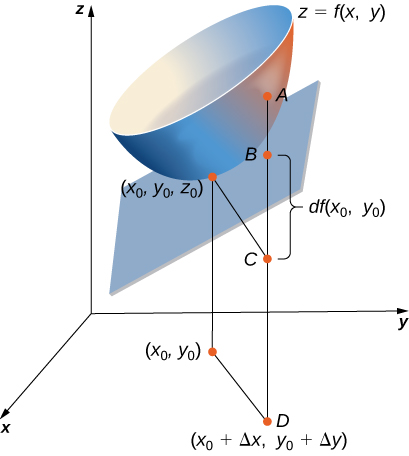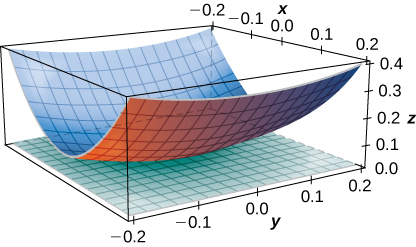6.4E:Exercises
- Page ID
- 25950
Exercise \(\PageIndex{1}\)
For the following exercises, find a unit normal vector to the surface at the indicated point.
1) \(\displaystyle f(x,y)=x^3,(2,−1,8)\)
- Answer
-
\(\displaystyle (\frac{\sqrt{145}}{145})(12 \hat{\mathbf{i}− \hat{\mathbf{k})\)
2) \(\displaystyle ln(\frac{x}{y−z})=0\) when \(\displaystyle x=y=1\)
Exercise \(\PageIndex{2}\)
For the following exercises, as a useful review for techniques used in this section, find a normal vector and a tangent vector at point \(\displaystyle P\).
3) \(\displaystyle x^2+xy+y^2=3,P(−1,−1)\)
- Answer
-
Normal vector: \(\displaystyle \hat{\mathbf{i}+ \hat{\mathbf{j}\), tangent vector: \(\displaystyle − \hat{\mathbf{j}\)
4) \(\displaystyle (x^2+y^2)^2=9(x^2−y^2),d(\sqrt{2},1)\)
5) \(\displaystyle xy^2−2x^2+y+5x=6,P(4,2)\)
- Answer
-
Normal vector: \(\displaystyle 7 \hat{\mathbf{i}−17 \hat{\mathbf{j}\), tangent vector: \(\displaystyle 7 \hat{\mathbf{i}+7 \hat{\mathbf{j}\)
6) \(\displaystyle 2x^3−x^2y^2=3x−y−7,P(1,−2)\)
7) \(\displaystyle ze^{x^2−y^2}−3=0, P(2,2,3)\)
- Answer
-
\(\displaystyle −1.094 \hat{\mathbf{i}−0.18238 \hat{\mathbf{j}\)
Exercise \(\PageIndex{3}\)
For the following exercises, find the equation for the tangent plane to the surface at the indicated point. (Hint: Solve for \(\displaystyle z\) in terms of \(\displaystyle x\) and \(\displaystyle y\).)
8) \(\displaystyle −8x−3y−7z=−19,P(1,−1,2)\)
9) \(\displaystyle z=−9x^2−3y^2,P(2,1,−39)\)
- Answer
-
\(\displaystyle −36x−6y−z=−39\)
10) \(\displaystyle x^2+10xyz+y^2+8z^2=0,P(−1,−1,−1)\)
11) \(\displaystyle z=ln(10x^2+2y^2+1),P(0,0,0)\)
- Answer
-
\(\displaystyle z=0\)
12) \(\displaystyle z=e^{7x^2+4y^2}, P(0,0,1)\)
13) \(\displaystyle xy+yz+zx=11,P(1,2,3)\)
- Answer
-
\(\displaystyle 5x+4y+3z−22=0\)
14) \(\displaystyle x^2+4y^2=z^2,P(3,2,5)\)
15) \(\displaystyle x^3+y^3=3xyz,P(1,2,\frac{3}{2})\)
- Answer
-
\(\displaystyle 4x−5y+4z=0\)
16) \(\displaystyle z=axy,P(1,\frac{1}{a},1)\)
17) \(\displaystyle z=sinx+siny+sin(x+y),P(0,0,0)\)
- Answer
-
\(\displaystyle 2x+2y−z=0\)
18) \(\displaystyle h(x,y)=ln\sqrt{x^2+y^2},P(3,4)\)
19) \(\displaystyle z=x^2−2xy+y^2,P(1,2,1)\)
- Answer
-
\(\displaystyle −2(x−1)+2(y−2)−(z−1)=0\)
Exercise \(\PageIndex{4}\)
For the following exercises, find parametric equations for the normal line to the surface at the indicated point. (Recall that to find the equation of a line in space, you need a point on the line, \(\displaystyle P_0(x_0,y_0,z_0)\), and a vector \(\displaystyle n=⟨a,b,c⟩\) that is parallel to the line. Then the equation of the line is \(\displaystyle x−x_0=at,y−y_0=bt,z−z_0=ct.)\)
20) \(\displaystyle −3x+9y+4z=−4,P(1,−1,2)\)
21) \(\displaystyle z=5x^2−2y^2,P(2,1,18)\)
- Answer
-
\(\displaystyle x=20t+2,y=−4t+1,z=−t+18\)
22) \(\displaystyle x^2−8xyz+y^2+6z^2=0,P(1,1,1)\)
23) \(\displaystyle z=ln(3x^2+7y^2+1),P(0,0,0)\)
- Answer
-
\(\displaystyle x=0,y=0,z=t\)
24) \(\displaystyle z=e^{4x^2+6y^2},P(0,0,1)\)
25) \(\displaystyle z=x^2−2xy+y^2\) at point \(\displaystyle P(1,2,1)\)
- Answer
-
Solution:\(\displaystyle x−1=2t;y−2=−2t;z−1=t\)
Exercise \(\PageIndex{5}\)
For the following exercises, use the figure shown here.

26) The length of line segment \(\displaystyle AC\) is equal to what mathematical expression?
27) The length of line segment \(\displaystyle BC\) is equal to what mathematical expression?
- Answer
-
The differential of the function \(z(x,y)\) is \(dz=f_xdx+f_ydy\)
28) Using the figure, explain what the length of line segment \(\displaystyle AB\) represents.
Exercise \(\PageIndex{6}\)
For the following exercises, complete each task.
29) Show that \(\displaystyle f(x,y)=e^{xy}x\) is differentiable at point \(\displaystyle (1,0).\)
- Answer
-
Using the definition of differentiability, we have \(\displaystyle e^{xy}x≈x+y.\)
30) Find the total differential of the function \(\displaystyle w=e^ycos(x)+z^2.\)
31) Show that \(\displaystyle f(x,y)=x^2+3y\) is differentiable at every point. In other words, show that \(\displaystyle Δz=f(x+Δx,y+Δy)−f(x,y)=f_xΔx+f_yΔy+ε_1Δx+ε_2Δy\), where both \(\displaystyle ε_1\) and \(\displaystyle ε_2\) approach zero as \(\displaystyle (Δx,Δy)\) approaches \(\displaystyle (0,0).\)
- Answer
-
\(\displaystyle Δz=2xΔx+3Δy+(Δx)^2.(Δx)^2→0\) for small \(\displaystyle Δx\) and \(\displaystyle z\) satisfies the definition of differentiability.
32) Find the total differential of the function \(\displaystyle z=\frac{xy}{y+x}\) where \(\displaystyle x\) changes from \(\displaystyle 10\) to \(\displaystyle 10.5\) and \(\displaystyle y\) changes from \(\displaystyle 15\) to \(\displaystyle 13\).
33) Let \(\displaystyle z=f(x,y)=xe^y.\) Compute \(\displaystyle Δz\) from \(\displaystyle P(1,2)\) to \(\displaystyle Q(1.05,2.1)\) and then find the approximate change in \(\displaystyle z\) from point \(\displaystyle P\) to point \(\displaystyle Q\). Recall \(\displaystyle Δz=f(x+Δx,y+Δy)−f(x,y)\), and \(\displaystyle dz\) and \(\displaystyle Δz\) are approximately equal.
- Answer
-
\(\displaystyle Δz≈1.185422\) and \(\displaystyle dz≈1.108.\) They are relatively close.
34) The volume of a right circular cylinder is given by \(\displaystyle V(r,h)=πr^2h.\) Find the differential \(\displaystyle dV\). Interpret the formula geometrically.
35) See the preceding problem. Use differentials to estimate the amount of aluminum in an enclosed aluminum can with diameter \(\displaystyle 8.0cm\) and height \(\displaystyle 12cm\) if the aluminum is \(\displaystyle 0.04\) cm thick.
- Answer
-
\(\displaystyle 16cm^3\)
36) Use the differential \(\displaystyle dz\) to approximate the change in \(\displaystyle z=\sqrt{4−x^2−y^2}\) as \(\displaystyle (x,y)\) moves from point \(\displaystyle (1,1)\) to point \(\displaystyle (1.01,0.97).\) Compare this approximation with the actual change in the function.
37) Let \(\displaystyle z=f(x,y)=x^2+3xy−y^2.\) Find the exact change in the function and the approximate change in the function as \(\displaystyle x\) changes from \(\displaystyle 2.00\) to \(\displaystyle 92.05\) and \(\displaystyle y\) changes from \(\displaystyle 3.00\) to \(\displaystyle 2.96\).
- Answer
-
\(\displaystyle Δz=\) exact change \(\displaystyle =0.6449\), approximate change is \(\displaystyle dz=0.65\). The two values are close.
38) The centripetal acceleration of a particle moving in a circle is given by \(\displaystyle a(r,v)=\frac{v^2}{r},\) where \(\displaystyle v\) is the velocity and \(\displaystyle r\) is the radius of the circle. Approximate the maximum percent error in measuring the acceleration resulting from errors of \(\displaystyle 3%\) in \(\displaystyle v\) and \(\displaystyle 2%\) in \(\displaystyle r\). (Recall that the percentage error is the ratio of the amount of error over the original amount. So, in this case, the percentage error in a is given by \(\displaystyle \frac{da}{a}\).)
39) The radius \(\displaystyle r\) and height \(\displaystyle h\) of a right circular cylinder are measured with possible errors of \(\displaystyle 4%\) and \(\displaystyle 5%\), respectively. Approximate the maximum possible percentage error in measuring the volume (Recall that the percentage error is the ratio of the amount of error over the original amount. So, in this case, the percentage error in \(\displaystyle V\) is given by \(\displaystyle \frac{dV}{V}\).)
- Answer
-
\(\displaystyle 13%\) or \(\displaystyle 0.13\)
40) The base radius and height of a right circular cone are measured as \(\displaystyle 10\) in. and \(\displaystyle 25\) in., respectively, with a possible error in measurement of as much as \(\displaystyle 0.1\) in. each. Use differentials to estimate the maximum error in the calculated volume of the cone.
41) The electrical resistance \(\displaystyle R\) produced by wiring resistors \(\displaystyle R_1\) and \(\displaystyle R_2\) in parallel can be calculated from the formula \(\displaystyle \frac{1}{R}=\frac{1}{R_1}+\frac{1}{R_2}\). If \(\displaystyle R_1\) and \(\displaystyle R_2\) are measured to be \(\displaystyle 7Ω\) and \(\displaystyle 6Ω\), respectively, and if these measurements are accurate to within \(\displaystyle 0.05Ω\), estimate the maximum possible error in computing \(\displaystyle R\). (The symbol \(\displaystyle Ω\) represents an ohm, the unit of electrical resistance.)
- Answer
-
\(\displaystyle 0.025\)
42) The area of an ellipse with axes of length \(\displaystyle 2a\) and \(\displaystyle 2b\) is given by the formula \(\displaystyle A=πab\). Approximate the percent change in the area when \(\displaystyle a\) increases by \(\displaystyle 2%\) and \(\displaystyle b\) increases by \(\displaystyle 1.5%.\)
43) The period \(\displaystyle T\) of a simple pendulum with small oscillations is calculated from the formula \(\displaystyle T=2π\sqrt{\frac{L}{g}}\), where \(\displaystyle L\) is the length of the pendulum and \(\displaystyle g\) is the acceleration resulting from gravity. Suppose that \(\displaystyle L\) and \(\displaystyle g\) have errors of, at most, \(\displaystyle 0.5%\) and \(\displaystyle 0.1%\), respectively. Use differentials to approximate the maximum percentage error in the calculated value of \(\displaystyle T\).
- Answer
-
\(\displaystyle 0.3%\)
44) Electrical power \(\displaystyle P\) is given by \(\displaystyle P=\frac{V^2}{R}\), where \(\displaystyle V\) is the voltage and \(\displaystyle R\) is the resistance. Approximate the maximum percentage error in calculating power if \(\displaystyle 120 V\) is applied to a \(\displaystyle 2000−Ω\) resistor and the possible percent errors in measuring \(\displaystyle V\) and \(\displaystyle R\) are \(\displaystyle 3%\) and \(\displaystyle 4%\), respectively.
Exercise \(\PageIndex{7}\)
For the following exercises, find the linear approximation of each function at the indicated point.
45) \(\displaystyle f(x,y)=x\sqrt{y},P(1,4)\)
- Answer
-
\(\displaystyle 2x+\frac{1}{4}y−1\)
46) \(\displaystyle f(x,y)=e^xcosy;P(0,0)\)
47) \(\displaystyle f(x,y)=arctan(x+2y),P(1,0)\)
- Answer
-
\(\displaystyle \frac{1}{2}x+y+\frac{1}{4}π−\frac{1}{2}\)
48) \(\displaystyle f(x,y)=\sqrt{20−x^2−7y^2},P(2,1)\)
49) \(\displaystyle f(x,y,z)=\sqrt{x^2+y^2+z^2},P(3,2,6)\)
- Answer
-
\(\displaystyle \frac{3}{7}x+\frac{2}{7}y+\frac{6}{7}z\)
50) [T] Find the equation of the tangent plane to the surface \(\displaystyle f(x,y)=x^2+y^2\) at point \(\displaystyle (1,2,5),\) and graph the surface and the tangent plane at the point.
51) [T] Find the equation for the tangent plane to the surface at the indicated point, and graph the surface and the tangent plane: \(\displaystyle z=ln(10x^2+2y^2+1),P(0,0,0).\)
- Answer
-
\(\displaystyle z=0\)

52) [T] Find the equation of the tangent plane to the surface \(\displaystyle z=f(x,y)=sin(x+y^2)\) at point \(\displaystyle (\frac{π}{4},0,\frac{\sqrt{2}}{2})\), and graph the surface and the tangent plane.


